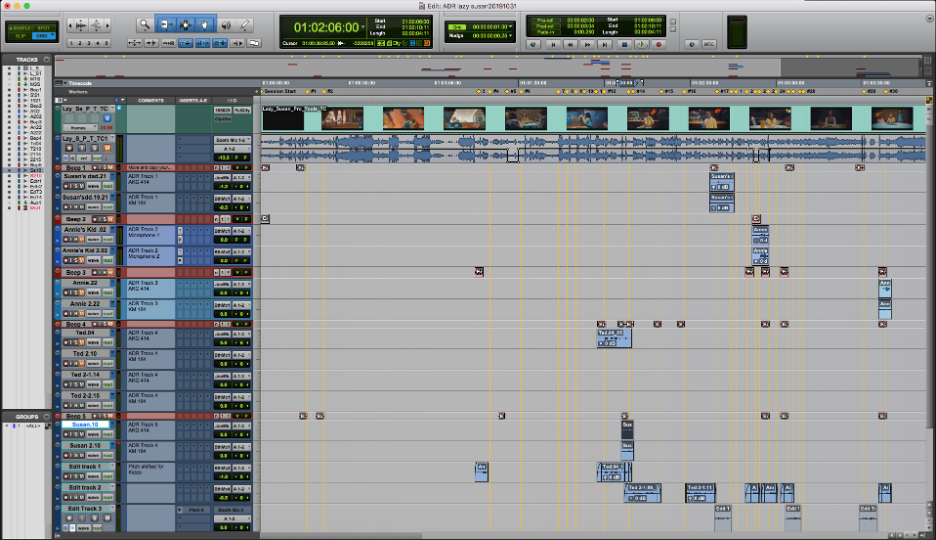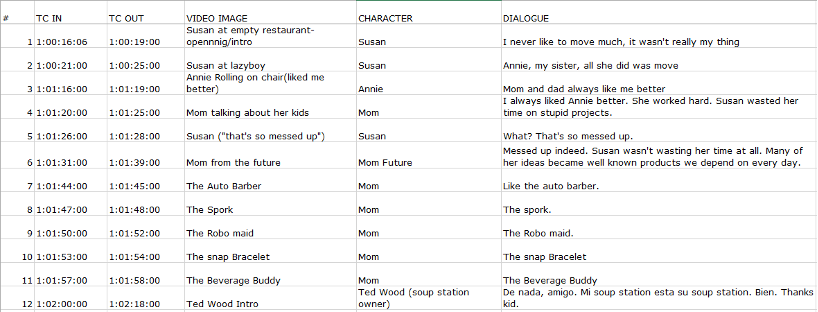DIALOGUE
With the exception of the one character that provides the main narration, the dialogue in this production comes in short bursts. Most of which is used to directly drive the plot and tell the story. Most of the other elements in the soundtrack move out of the way of the dialogue. Therefore the dialogue has plenty of breathing room which makes it difficult for clashing to occur. However, the room noises and ambiance should be EQ'ed so that it leaves room in the frequency domain as well. In addition, we should ensure that there is little reverb in the dialogue as all of the actors are always in close shots or centered in front of the camera. This can be done using the reverb removal tool in Isotope RX if needed and making sure that the actors are somewhat close to the microphones.
The first task to be completed was the the spotting notes. We went through the video and marked down all the lines’ timecodes, then filled in the lines afterward with some help from YouTube's automatically generated subtitles. The total lines weren’t excessive (not nearly as many as our sound effects in this video), but there are seven characters in total. In order to bring out the different characteristics in each character, we aimed to find distinct people to play the talent. Aside from Susan’s dad and Annie’s son, which were being played by the same talent, all other characters were performed by different talents. And since most of the actors in this video are Asians, we tried to find as many Asian people to do ADR as we could.
The recording booth setup consisted of two microphones: AKG 414 and Neumann KM 184. Both are good at picking up speaking vocals and don’t do much coloration. The 414 was placed at or near mouth level in front of the actor and set in a cardioid pattern with zero roll-off. The 184 was in the position that a standard boom microphone would be on set: above the actor and aimed towards their mouth. The lines were displayed on the screen for one person while the other opted to use a music stand for reading their lines. The on-screen lines were preferred as it would eliminate any possible extraneous noise coming from page turning and the music stand being bumped. In addition, a standless operation allows for the actor to have more room if required. The video was also displayed on the screen for the talent.
Because most of the dialogues are on-screen, we couldn’t change them, and the emotion of the talents couldn’t be too different from the actors in the short film. But we tried to give the talents as much freedom as we could. We started by playing the video with original sound and beeps, let the talents practice their lines, emotions and sync. After they felt comfortable with sound off, we turned off the sound and let them practice with beeps. When they were ready, we will start recording. We didn’t apply loop recording because we think that it would be better for the talent to rest a little bit and reflect what they did before moving on to the next take. Sometimes we would give suggestions/coaching on how to act or pronounce some key words. Using adjectives helped a lot, we tried to describe the background of the character or their feelings at the moment to help the talents get into the scene. If they weren’t able to perform well several takes in a row, we would go back with sound and let them practice more, or took a little break.
Each clip/take was gain-matched for consistency and a small amount of compression was applied. In addition, the track used for Annie’s child was pitched and shifted a couple of steps because the voice actor was much older. Susan’s dad was pitched lower in order to match the type of character.



